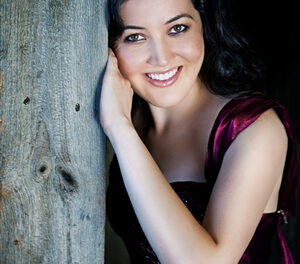If you are wondering how to spend Sunday afternoon in the Piedmont Triad, stop and make plans to attend the Sunday afternoon classical concert of the Winston-Salem Symphony at Reynolds Auditorium. Based on the superlative performance Saturday night, expect to hear an outstanding piano soloist, Michelle Cann, play the Rachmaninoff Piano Concerto No. 2 with power and delicacy. She surprised the audience with her encore, a jazzy version of another Rachmaninoff gem, the Prélude in C-sharp minor.
The Rachmaninoff Second Piano Concerto is a difficult one to accompany, starting with the composer’s decision to create deliberate “mis-matches” between the piano soloist’s rhythm and that of the accompaniment (notably in the second movement, which opposes twelve eighth notes divided into three groups of four notes in the accompaniment, whereas the melody divides those same twelve notes into four groups of three), creating musical tension. Another difficulty is the composer’s propensity for ending musical phrases of the solo part with a downbeat pizzicato in the orchestra, obliging the conductor to coordinate forty stringed “pluckers” with a romantic phrase ending at the whim of the soloist. Michelle Merrill, the new Maestra of the Winston-Salem Symphony, was outstanding at this, and she anticipated the impulsive breakaway passages which dramatically changed tempos from one phrase to the next! Principal clarinetist Anthony Taylor had some awesome solos in the quieter moments of the concerto. The audience was delighted, and cheered at the triumphant closing of the concerto.
In the second half of the concert, the orchestra played an impressive performance of Shostakovich’s Fifth Symphony, the best-known symphony of the fifteen composed by Shostakovich. The orchestra is sounding at its best under their new maestra, with suspense-filled soft passages spinning in the highest string register, and finally resolving in thrilling and satisfying full voiced fortissimi. A great number of outstanding soloists were featured in the Shostakovich - the tender duet in the first movement between principal flutist Kathryn Levy and principal horn Robert Campbell was thrilling. The Scherzo gave us amusing character sketches from the high-pitched E-flat clarinetist, Eileen Young, and concertmaster Corine Brouwer. Several oboe solos brought attention to Amanda LaBrecque who seems to get better and better with each concert. But the real hero of the day was the new music director for challenging the musicians to dare to walk the tight-rope of playing extra soft, extra fast, or extra slow, whatever the music demanded to make the most of any moment, and then to unite it all together meaningfully. Brava Maestra!
The evening opened with an extended tribute paid to Anita Cirba, principal trumpet of the Winston-Salem Symphony (as well as the Greensboro Symphony) who is now retiring after four rich and colorful decades with the orchestra. She will be missed by musicians as well as audiences. This was followed by a charming and exciting seven-minute piece entitled “Luster,” a work full of shimmering colors and sounds, by UNC School of the Arts faculty member Jared Miller. Flutes and marimba opened and closed the piece, which featured some powerful rhythmic moments in the middle.
The Winston-Salem Symphony will be performing more frequently on the stage of Reynolds Auditorium while the Stevens Center, the orchestra’s principal home for the last 40 years, undergoes a major renovation, expected to last two years. As has often been said, “The first condition for a great orchestra is a great hall!” Of course, the audience demands a great sounding hall which mixes and blends sounds as the musicians and conductor produce them. But far more is required of a hall so that the sound that returns to the stage to the ears of the players accurately reflects what the audience hears. This reflexive give-and-take provides the sensitive and alert musician with information necessary for expressive and meaningful performances. Of course, not all styles of music require this acoustically based sharing of information - think of the huge musical industry which could not have existed before electronic tools were put into the hands of creative musicians and engineers (and in the headphones of music-lovers) since the second half of the last century!
But the hope of creating a soundscape and interactive feedback loops with acoustic instruments in surroundings with subpar acoustics is often doomed, as are solutions which rely exclusively on electronics, which is why musicians often smile at the expression, “all-purpose hall,” as there are none that serve every purpose adequately.












